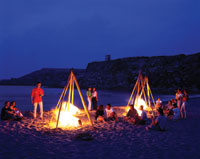Malta for stronger ties with Gulf markets

How much does the Middle East contribute to tourism in Malta? How do you plan to increase that? Do you think the signing of the Smart City project will help boost tourist arrivals from the region?
To date the Middle East plays a very small role in our efforts.
However, we want to take advantage of the regular Emirates connection linking Dubai, Larnaca and Malta to tap into this market in a more effective manner. Our forthcoming marketing plan for 2008-2010 will spell out our strategies and objectives for this market, which is today recognised as one of the fastest growing and most lucrative markets in the world.
Are you also looking at tourism-related investments from this region, particularly from Dubai?
The Smart City project with a high focus on ICT, will also lead to tourism related investments from Dubai. Not surprisingly, the project includes the building of a hotel.
Tourist arrivals in Malta last year were four per cent less than the previous year, what were the major factors for lower figures and how do you plan to attract more tourists this year? What are the major markets Malta is currently focussing on? Are you looking at any new markets?
The decline was due to a number of factors influencing our two main markets, namely the UK and Germany. Apart from effect of FIFA World Cup, the UK market was very heavily influenced by the effects on travel of the foiled terror attacks on aircraft during peak season. A destination like Malta which is totally dependent on air travel felt the brunt of the decline in air travel during August more than other destinations which attract alternative types of tourism. In Germany, it was a seat capacity problem which resulted in demand for Malta not being satisfied due to non availability of aircraft seats during crucial peak periods for the German market such as spring and autumn. The late introduction of LCC services from the UK also impacted 2006, as Malta was not capable of benefiting from this growing segment during ten months of 2006, while at the same, time Malta was suffering from a decline in tour operator traffic something which has been rectified since the start of the winter 2006/7 season through the introduction of regular Ryanair flights from Luton, Pisa and Dublin. Malta continues to focus on its core European markets whilst examining the potential of emerging markets from both the short haul and the long haul.
How is the MICE market doing?
The MICE market continues to be a top performer with around 64,000 MICE related travellers coming into Malta during 2006. Malta offers state-of-the-art hotels and facilities for this market together with a fine climate and a varied offer which makes it a very attractive and versatile venue. The MICE share of total volume is around five per cent but its share of expenditure is around 15 per cent.
What new hospitality projects are taking shape in Malta?
Malta's tourism offer is constantly in motion with refurbishments, upgrading, extensions and outright new investments. Besides the primary tourism product the island's tourist offer is also benefiting from the injection of substantial EU structural funds which besides being used for general infrastructural upgrading, are also being allocated for projects of direct tourism relevance ranging from beach development to resort upgrading and preservation/presentation of historical and cultural sites.
